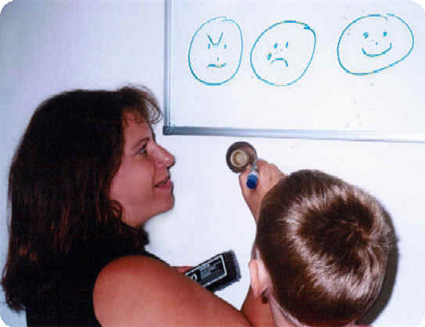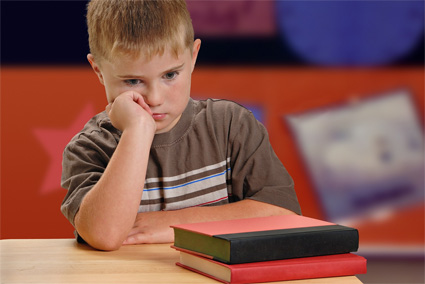Psychotherapy treatment for depression in children is a very effective treatment option. It commences with complete understanding of the personality of the child. Success of treatment depends on the identification of root of depression by getting acquainted with the child. Read on to know more. Doctors and counsellors often suggest psychotherapy as the first method of treatment for depression in children. This therapy is basically an accumulation of techniques that every counsellor uses in his own way. Firstly he or she must be a trained mental healthcare professional. The objective is to determine and address the root cause of depression. In this articleCustomary Interview of ChildAnalysing Child’s Behaviour and EmotionIdentifying the Cause of DepressionCreating a Pleasing Environment for ChildIndividual, Family and GroupPsychodynamic MethodCognitive Behavioural TherapyHow Does Psychotherapy Work? As mentioned earlier every counsellor has his own way of approach, with the basic intention being to know and understand the personality of the child as intimately as possible. Here is how the treatment procedure commences: Customary Interview of Child – The very first step is to invite the child or visit the child for a customary interview. The point to note is that the setting should not be clinical at all, as this may make the child withdraw further more into his shell. The environment should casual and conducive for a child to open up. Analysing Child’s Behaviour and Emotion –Through initial and continuous observation and talking, the psychotherapist tries to note and analyse every behaviour and emotion of the child. He then processes them to form an idea of the child’s overall personality and the possible causes that contribute to depression.Identifying the Cause of Depression –Through conversation with the child and accumulation of information from his or her parents and teachers and friends, the psychotherapist understands and identifies the problems or events that have now mounted to depression. The causes can be death in the family, problem in relationship with the mother or father, best friend, classmate or a comment by the teacher or even witnessing a very sick patient. Now, possible solutions are sought to the problem for improving the child’s condition. Creating a Pleasing Environment for Child –Help the child understand through reiteration and display that life is something to be enjoyed and be happy about. Help create an environment of joy and pleasure by advising the parents on necessary steps and ideas. Help the child develop a sense of control and this includes inculcating problem solving skills and techniques in coping with difficulties. Approaches to the Psychotherapy Following are the approaches to the psychotherapy for treating depression in children. Individual, Family and Group –This means that the psychotherapist may call for individual session with the child only, or his family or his friends and/or teachers. Depending on the cause for depression and the current mental health, the approach is decided. This action greatly helps in understanding and controlling the environment of the child, which makes treatment easier. Psychodynamic Method –This method has more to do with the individual session where the psychotherapist encourages the child to talk about his feelings, thoughts and fears. The objective is to bring out all the hidden or bottled up emotions and thoughts that have accumulated for long to give rise to the present depressive state. By talking, the actual underlying problem or problems come to the fore and once these thoughts or fears are expressed, the child finds himself in a better position to listen to the possible solutions offered by the counsellor. These are mostly found to be unresolved and unconscious conflicts. Cognitive Behavioural Therapy – Depression in childhood is often caused by inaccurate perceptions regarding events or people. Through conversation the therapist helps the child to adopt a new way of looking at things, thereby helping him change his outlook towards life. It is inducing positivity through directions. The main idea of psychotherapy is to get acquainted with the child in the best possible way. Because the root of depression, be it personal or environmental lies within him. Once the therapist enters his inner world, he is better able to identify and solve the problem in the best way possible. Its success depends on the ability to understand with compassion.
Psychotherapy treatment for depression in children is a very effective treatment option. It commences with complete understanding of the personality of the child. Success of treatment depends on the identification of root of depression by getting acquainted with the child. Read on to know more. Doctors and counsellors often suggest psychotherapy as the first method of treatment for
depression in children. This therapy is basically an accumulation of techniques that every counsellor uses in his own way. Firstly he or she must be a trained mental healthcare professional. The objective is to determine and address the root cause of depression.
How Does Psychotherapy Work?
As mentioned earlier every counsellor has his own way of approach, with the basic intention being to know and understand the personality of the child as intimately as possible. Here is how the treatment procedure commences:
Customary Interview of Child –
The very first step is to invite the child or visit the child for a customary interview. The point to note is that the setting should not be clinical at all, as this may make the child withdraw further more into his shell. The environment should casual and conducive for a child to open up.
Analysing Child’s Behaviour and Emotion –
Through initial and continuous observation and talking, the psychotherapist tries to note and analyse every behaviour and emotion of the child. He then processes them to form an idea of the child’s overall personality and the possible causes that contribute to depression.
Identifying the Cause of Depression –
Through conversation with the child and accumulation of information from his or her
parents and teachers and friends, the psychotherapist understands and identifies the problems or events that have now mounted to depression.
The causes can be death in the family, problem in relationship with the mother or father, best friend, classmate or a comment by the teacher or even witnessing a very sick patient. Now, possible solutions are sought to the problem for improving the child’s condition.
Creating a Pleasing Environment for Child –
Help the child understand through reiteration and display that life is something to be enjoyed and be happy about. Help create an environment of joy and pleasure by advising the parents on necessary steps and ideas.
Help the child develop a sense of control and this includes inculcating problem solving skills and techniques in coping with difficulties.
Approaches to the Psychotherapy
Following are the approaches to the psychotherapy for treating depression in children.
Individual, Family and Group –
This means that the psychotherapist may call for individual session with the child only, or his family or his friends and/or teachers. Depending on the cause for depression and the current mental health, the approach is decided. This action greatly helps in understanding and controlling the environment of the child, which makes treatment easier.
Psychodynamic Method –
This method has more to do with the individual session where the psychotherapist encourages the child to talk about his
feelings, thoughts and
fears. The objective is to bring out all the hidden or bottled up emotions and thoughts that have accumulated for long to give rise to the present depressive state.
By talking, the actual underlying problem or problems come to the fore and once these thoughts or fears are expressed, the child finds himself in a better position to listen to the possible solutions offered by the counsellor. These are mostly found to be unresolved and unconscious conflicts.
Cognitive Behavioural Therapy –
Depression in childhood is often caused by inaccurate perceptions regarding events or people. Through conversation the therapist helps the child to adopt a new way of looking at things, thereby helping him change his outlook towards life. It is inducing positivity through directions.
The main idea of psychotherapy is to get acquainted with the child in the best possible way. Because the root of depression, be it personal or environmental lies within him. Once the therapist enters his inner world, he is better able to identify and solve the problem in the best way possible. Its success depends on the ability to understand with compassion.































